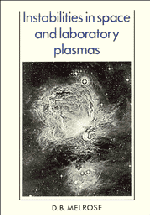Book contents
- Frontmatter
- Contents
- Preface
- Plasma formulary
- Part I Introduction to plasma theory
- Part II Instabilities in unmagnetized plasmas
- 3 Reactive instabilities
- 4 Kinetic instabilities
- 5 Particle motions in waves
- 6 Weak turbulence theory
- 7 Nonlinear instabilities and strong turbulence
- Part III Collision-dominated magnetized plasmas
- Part IV Instabilities in magnetized collisionless plasmas
- Appendix A The plasma dispersion function
- Appendix B Bessel functions
- Appendix C Collision frequencies
- Appendix D Transport coefficients
- Bibliographical notes
- References
- List of commonly used symbols
- Author index
- Subject index
5 - Particle motions in waves
Published online by Cambridge University Press: 06 December 2010
- Frontmatter
- Contents
- Preface
- Plasma formulary
- Part I Introduction to plasma theory
- Part II Instabilities in unmagnetized plasmas
- 3 Reactive instabilities
- 4 Kinetic instabilities
- 5 Particle motions in waves
- 6 Weak turbulence theory
- 7 Nonlinear instabilities and strong turbulence
- Part III Collision-dominated magnetized plasmas
- Part IV Instabilities in magnetized collisionless plasmas
- Appendix A The plasma dispersion function
- Appendix B Bessel functions
- Appendix C Collision frequencies
- Appendix D Transport coefficients
- Bibliographical notes
- References
- List of commonly used symbols
- Author index
- Subject index
Summary
Perturbations in the orbit of a single particle
In plasma physics it is traditional to use a mixture of the collective-medium approach and the single-particle approach in treating various processes. These two approaches can complement each other in providing physical insight. A relevant example is in the treatment of Landau damping. In the collective-medium approach this is treated by allowing the frequency to have an imaginary part which is determined by the anti-hermitian part of the response tensor (§2.5). In the single-particle approach, one calculates Cerenkov emission by a single particle, relates absorption to emission using the Einstein coefficients (or Kirchhoff's law) and hence finds that Landau damping is the absorption process corresponding to Cerenkov emission by thermal electrons (§6.3). Although it is possible in principle to use the collective-medium approach to treat spontaneous, e.g. Cerenkov, emission it is cumbersome to do so and it is difficult to build up a physical understanding using this approach. Thus spontaneous emission is treated using a single-particle approach. This approach may be extended to calculate the response tensors (§5.5) which are the basis of the collective-medium approach.
In this Chapter we discuss several aspects of the single-particle approach applied to particle-wave interactions. The object is to identify the physical processes involved in reactive and kinetic instabilities, and in their saturation.
- Type
- Chapter
- Information
- Instabilities in Space and Laboratory Plasmas , pp. 63 - 78Publisher: Cambridge University PressPrint publication year: 1986



